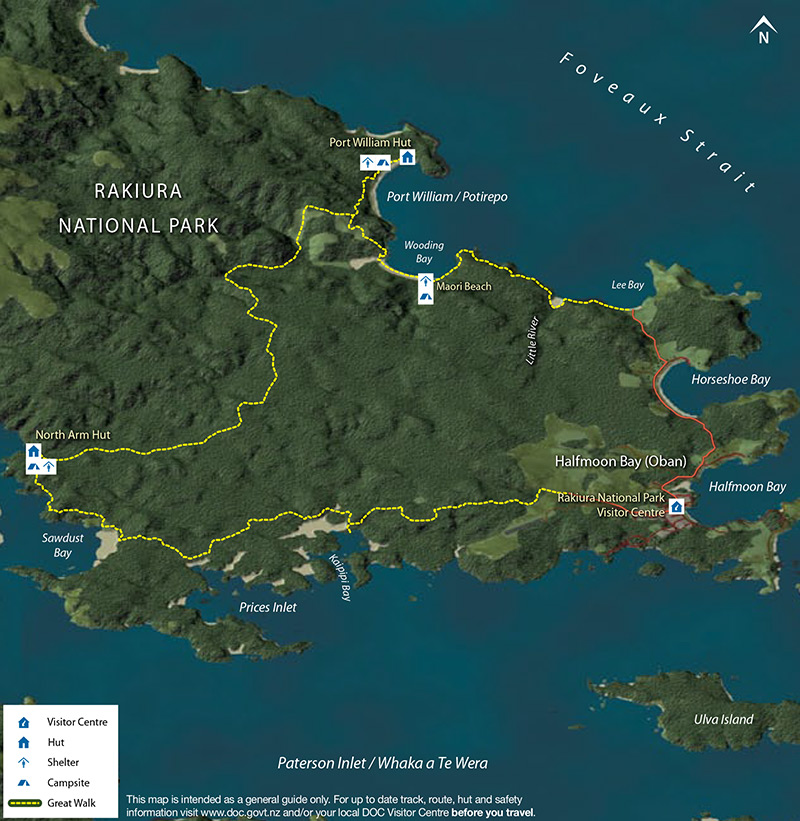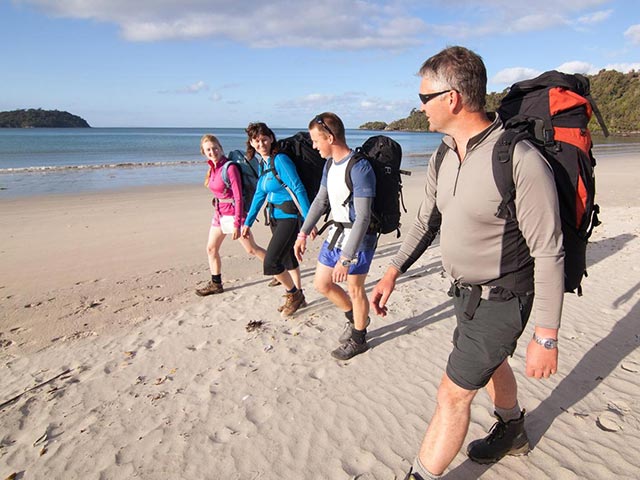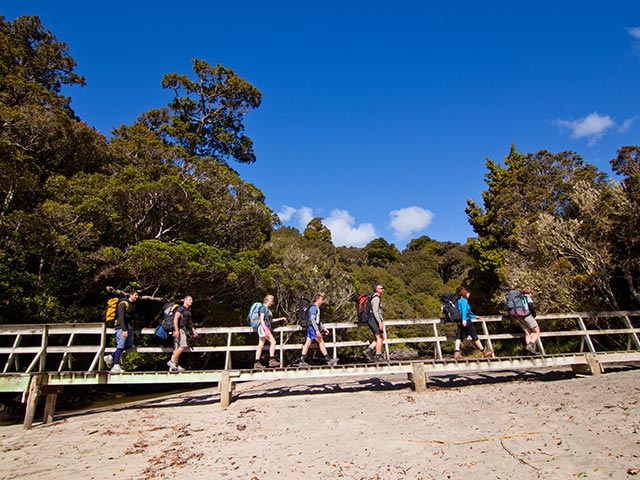Rakiura Track
The Rakiura Track passes through Rakiura National Park on Stewart Island
Distance: 37 km / Duration: 3 days
The Rakiura Track is one of the shortest of New Zealand’s Great Walks at 37km and takes 3 days. The journey starts by air with a short flight from Invercargill over Foveaux Strait. Starting and finishing in Halfmoon Bay (Oban) this remote island walk takes you far away from the bustle of civilisation and the more commercial tracks on the mainland. Untouched forests, tidal flats, rugged ocean views and the chance to see kiwi in their natural environment reward the more adventurous traveller seeking a less trodden path.
What’s included:
- Package includes 5 days and 4 nights
- Pre Accommodation in a 3 star motel or equivalent in Invercargill
- Post Accommodation in a 3 star motel or equivalent on Stewart Island (twin share)
- Transportation ex Invercargill to and from the walk (return flights Invercargill to Stewart Island)
- 3 Day Walk with 2 nights in Department of Conservation Huts
From NZ$ 444 per person
Numbers are limited – Book early to secure your space.
2020/2021 Season is open
Please note the walk is fully booked over the following dates:
- 05, 12, 20, 26-28 Nov 2020
- 02-06 Dec 2020
- 10 Dec 2020 – 11 Feb 2021
- 20-21 Feb 2021
- 01-04, 20-25 Apr 2021
Independent Walking Guide

Day 1
Halfmoon Bay (Oban) to Port William Hut
12 km / 4 – 5 hours
Your journey starts from Oban’s Department of Conservation visitor centre as you head toward Lee Bay. Pass through a chain link structure representing the forming of Rakiura National Park and make your way to Little River toward Maori Beach. Follow the beach along the coastline before a climb up a ridge through forest then down to the water’s edge again to your first evening’s stop at Port William Hut at the end of Magnetic Beach.
Day 2
Port William Hut to North Arm Hut
13 km / 6 hours
Heading inland you pass through a former logging area which is now covered in regrowth of podocarp forest mixed with original native vegetation. A number of bridged creeks follow as you head toward your day’s destination of North Arm Hut at Paterson Inlet.
Day 3
North Arm Hut to Halfmoon Bay (Oban)
11 km / 4 – 4.5 hours
A sawmill track brings you past bays, through forest and and amongst wildlife and birds on the shore of Paterson Inlet. The walk along halfmoon bay is populated by rimu and kamahi trees as you return to Oban.
More Details On The Walk
What should I bring?
To enjoy freedom walking a spare set of the clothes and underwear you are most comfortable wearing will ensure the hours on the track are a pleasure not a chore. Drying garments in the hut is often not possible for safety reasons so polypropylene and light wool with its fast drying qualities and ability to keep you warm even when it is wet is the most recommended material. Cotton clothing such as jeans, T-shirts and sweatshirts can be a serious liability when wet and have been responsible for a number of hypothermic incidents for hikers caught out in the cold.
Temperatures can vary during the day, with rain, sun and snow possible all on the same day at any time of the year. To ensure your clothing and sleeping bag stays dry we recommend you line your pack with a strong plastic bag before packing your gear into it.
Suggested clothing for the walks
- Sunhat, sunglasses and sunscreen
- Swimming costume and towel (optional)
- Good quality walking / tramping boots
- Good quality warm wind and rain proof jacket (gortex or similar)
- Light weight shoes for around the hut
- 2 – 3 sets of fast drying clothing. One set to walk in and one set to change into at night. Layers of clothing are recommended to manage changing temperatures. It is not possible to dry clothing at the huts.
- Warm hat and gloves
Personal equipment
- Water bottle — There is limited access to water on some places on the track
- Earplugs (optional), but you will be sharing the huts other people
- Pack with large waterproof / pack liner
- Sleeping bag and sleeping bag liner
- Toilet gear — Toothbrush, toothpaste, toilet paper, small towel, soap
- Torch and spare batteries — There is no lighting at the huts either in the living area or bunk rooms or between huts and ablution blocks
- Camera (optional)
- First aid kit — Insect repellent, plasters for blisters, personal medication (e.g. antihistamine for allergy to wasp stings)
- Rubbish bag — You must remove all your rubbish from the track
- Plastic bags for wet gear
Cooking
- Cooking utensils — Pot/pan/billy, matches or lighter
- Eating utensils — Knife, fork, spoon, plate, cup
- Small gas cooker if you want hot drinks etc during the day
- Pot scrubber, tea towel
Food
Food must be carried as it cannot be bought on the way, although some bartering may be possible especially if you have extra chocolate, gourmet cheeses or wine. Breakfast cereals, crackers, cheese and jam for lunch and instant soup/dried pasta or dehydrated meals for dinner, snacks such as biscuits, muesli bars and tea and coffee will ensure you keep up energy levels without losing your appetite. Supermarkets in Invercargill will be able to supply all your food requirements. There are also speciality outdoor stores which have a range of dehydrated meals and other food products specifically designed for multi-day walking.
Facilities at your accommodation
- While not five star, the huts you stay in have all the essentials you need for shelter and cooking with sinks, gas cookers, cold water, tables, seating benches and wood burners for heating and as well as solar lighting
- Communal bunkrooms have no pillows or linen and are built with a combination of platform and/or individual bunks with mattresses
- Ablution blocks have flush or vaulted toilets and washbasins with cold water only. Those wishing for showers or baths can enjoy the number of waterfalls or swimming holes on the track
- Department of Conservation rangers are present on the track but not at each hut
Explore More Today
Stewart Island is know for its wild, dramatic climates and landscapes so be prepared for all conditions for your two nights on the track.
Walkers are responsible for your own and party members safety. The Department of Conservation have a new online Intentions System which replaces the intentions books at each hut. It is crucial for walkers to advise others of their intentions regarding dates and routes taken before they embark on the Rakiura Track. Emergency locator beacons are also readily available for rent from Department of Conservation offices.
Take a moment to watch the short video and explore the maps then you will begin to understand what makes this remote location of New Zealand suitable for tramping all year round.

Great Walks Tracks are well marked and easy to follow but you will need a reasonable standard of fitness to carry your pack over the climbs and descents of the beautiful landscapes to each night’s accommodation. The walking times listed below are approximate times for an average walker taking short breaks each hour.

 Rakiura Track
Rakiura Track Rakiura Track
Rakiura Track